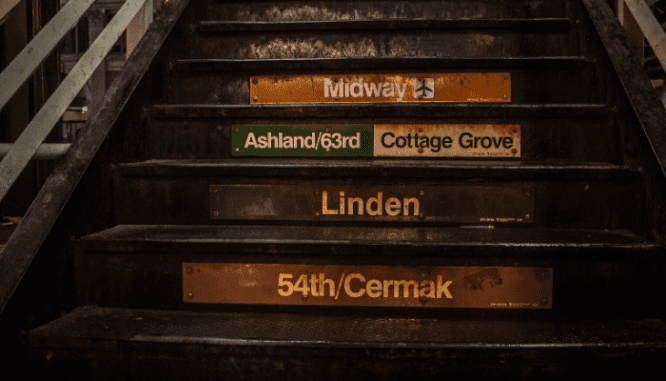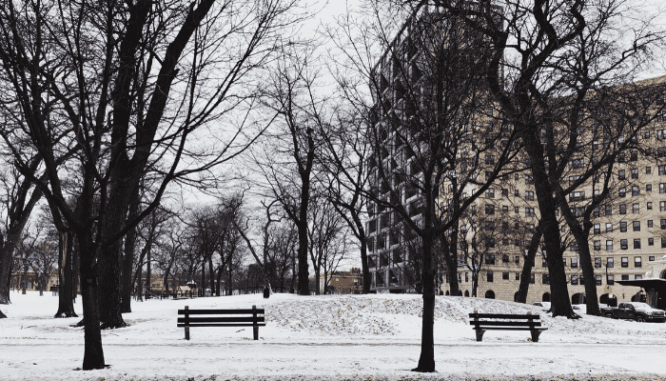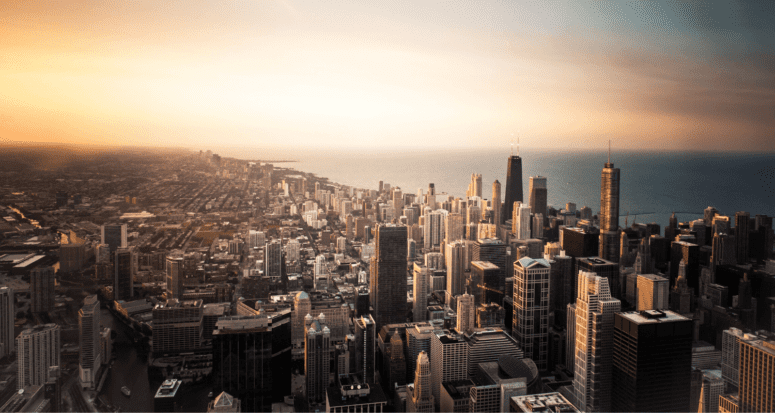Buying a House in Chicago: Your Windy City Guide
- Published on
- 4 min. read
-
 Liz Brown Contributing AuthorClose
Liz Brown Contributing AuthorClose Liz Brown Contributing Author
Liz Brown Contributing AuthorLiz Brown is a San Francisco Bay Area writer. On the real estate front, she’s written cost guides and articles about home and local services for companies including Yelp and Rewire.
Sinatra said it best: “And each time I roam, Chicago is calling me home, Chicago is why I just grin like a clown — it’s my kind of town…”
From Millennium Park (home to the famous Bean), to July’s delicious tradition of the Taste of Chicago, it’s easy to fall in love with this city.
However, that doesn’t mean it’s that easy to buy a house in Chicago. Even though the city is more affordable than other big cities such as New York and San Francisco, you have to keep in mind additional expenses that can zap your savings. You’ll want to budget for a few things, including the cost of maintenance needed for the winter season, the financial differences between renting and buying, and other unexpected property costs and fees.
To help make the decision to buy a home in Chicago easier, we talked to Danielle Dowell, who has more than a decade of experience in Chicago real estate, and Michael Spaargaren, owner of First Choice Inspectors, who has inspected just about every kind of oddity in Chicago housing. We’ve also scoured the interwebs to put together the most comprehensive guide that’ll work for your budget, lifestyle, and dreams of making it in the Windy City.

What’s the housing like in Chicago?
As with the start of any good housing search, you’ll want to know what’s readily available. Chicago is known for its amazing architecture, and housing is no exception. The most classic types of Chicago houses that’ll make you want to stick a “sold” sign in the front yard include:
- The Worker cottage:
The original Chicago home built as early as the 1830s reaches one-and-a-half stories. Adorned with ornate Greek Revival and Queen Anne styles, you can still find them in neighborhoods like Bucktown, Wicker Park, Ukrainian Village, and Pilsen. - The bungalow:
Making up one-third of the city’s single-family housing stock, the bungalow is one-and-a-half stories high, brick, and features street-facing verandas and concrete entry stairs. This popular housing is found in an arc four to seven miles from downtown, creating the “Bungalow Belt.” - The frame two-flat:
Unique to Chicago and emerging in popularity in the early 1900s, the two-flat makes up more than 30% of Chicago’s housing stock. With an apartment on each floor, landlords tend to rent out one while living in the other. More than 60% of the housing stock in Little Village, Brighton Park, and West Garfield Park is made up of two-flats. - The Chicago greystone:
Like the New York brownstone, these are built as single-family and multi-family buildings with a distinct limestone facade. Named for the color, greystones are found in neighborhoods like North Lawndale, Woodlawn, and Lakeview.
Know what budget works for you in Chicago
When you think of your ideal house, you probably have a long wish list in mind. A front yard with a fence… Three bedrooms, no make that four… Browsing houses in Chicago can be fun when you’re window shopping. Before any of that can happen, you’ll need to plan a budget to buy a house in Chicago.
“The best part about Chicago is that it’s very cost-efficient when you look at really large cities,” says Dowell.
“When you get into other cities that are our size, the cost of real estate’s much higher.”
Buying a house in Chicago is more affordable than living in places like Los Angeles or New York City. AreaVibes estimates median real estate prices in Chicago at $225,200. Renting is more affordable than buying a house in Chicago, too, but not by much, according to a report from Attom Data Solutions.
You should also factor property taxes into your budget. You can easily find those using an Illinois Property Tax Calculator like SmartAsset. Unfortunately, property taxes are high in Chicago, and Illinois has the second-highest property taxes in the nation, according to Kiplinger. That’s why when mortgage rates are lower, you’ll want to jump on those to afford more house for the same monthly payment.
And in any city, but especially Chicago, you don’t want unexpected maintenance or hidden costs surprising you.
In addition to surviving the winter season (with temps as low as -23°) with a wintertime home maintenance checklist, you should be aware of the costs for furnace and ducts, chimney, pipes, and gutters.
You’ll need to replace the batteries in smoke alarms and carbon monoxide detectors a couple of times a year, as recommended by the United States Alliance Fire Protection. That’s especially important during the winter months when windows are closed and furnaces and fireplaces are working overtime.
A great step you could also take when looking to knock down costs and save money is understanding your future home’s energy usage with a home energy audit. You can do a self-assessment or even find a professional home energy auditor who’ll do room-by-room examinations.
Be prepared and expect the unexpected
You know how they say “it’s better to be safe than sorry”? Well, that’s also good advice to take before moving into your new home. Home inspectors are the extra set of eyes and hands you’ll need when buying a house in Chicago. When you need qualified professionals to inspect the home, they’re the ones who can properly review and verify that everything is in good condition.
Spaargaren, owner of a 5-star home inspection company in Chicago, recommends getting a sewer scope of the main sewer lateral, plus termite and radon inspections.
Checking for mold and asbestos is another good idea. New homeowners in Chicago should also look out for, “Poorly installed electrical, mold due to leaks, and damaged roofs from hail storms,” says Spaargaren.
“Red flags should be rehabs performed without any permits or done by a homeowner,” Spaargaren adds. “Make sure your home inspector carries E&O (errors and omissions) insurance and has several years’ experience.”
A thorough home inspection can be reassuring before you buy a house in Chicago. The home inspection should identify any potential problems, and possibly even help you get a better deal when negotiating.

With so many neighborhoods, where do you look first?
When looking for your ideal community in Chicago, you may also be interested in areas with high livability scores. The AARP Livability Index accesses seven categories to decide the scores: housing, neighborhood, transportation, environment, health, engagement, and opportunity. You can use this tool to find out your future neighborhood’s scores.
“All the areas are different from what you’d expect,” explains Dowell. “It’s kind of like personalities. Downtown is going to have most of your high rises — River North, Gold Coast Area, Streeterville.
“A really hot and hip area no matter what the architecture is, technically, is West Side. Logan Square, Wicker Park, Bucktown, Humboldt Park — those have really gained a lot of popularity.”
Streeterville is home to the Museum of Contemporary Art, beaches, and bars. It also features Navy Pier, a magical spot from summer to winter where you can enjoy incredible views from the year-round Centennial Wheel.
Logan Square is another historic neighborhood located on the northwest side of Chicago. This community boasts artists, musicians, and Logan Boulevard lined with limestone houses leading to the Illinois Centennial Monument, which was created by the architect of the Lincoln Memorial in Washington D.C.
Humboldt Park is on the West Side of Chicago. Here you can visit the National Museum of Puerto Rican Arts and Culture, view the annual Puerto Rican Parade, and walk through roses in the Jens Jensen Formal Garden. You can even paddle through the lagoon on a giant swan paddle boat from the boathouse.
Wicker Park and Bucktown are artsy neighborhoods with unique shops, trendy eats, and late-night dives. The 606, a repurposed rail line, shows an elevated view of the above neighborhoods in Chicago. It’s also home to some of the best indie music venues, clubs, and speakeasies.
River North, located on the Near North Side, is a popular and affluent neighborhood full of luxe bars, eateries, and art galleries. This neighborhood even includes the House of Blues, Museum of Contemporary Art, and Merchandise Mart, the largest LEED-EB (Leadership in Energy and Environmental and Design for Existing Buildings) in the world.
The Gold Coast neighborhood grew in the wake of the Great Chicago Fire when millionaire Potter Palmer built the Palmer Mansion, a 42-room castle. Other wealthy Chicagoans followed which made the Gold Coast one of the richest, historic neighborhoods in Chicago located close to Lake Michigan’s shoreline.

When to buy a house in Chicago — brave the cold when no one else will
The best time to make an offer on a house in Chicago is between November and January. The simple answer? Nobody wants to move in the winter.
“Chicago has such bad winters, typically. It’s just people don’t want to deal with it,” Dowell says. “If you want to get a good deal, it’s not so much the neighborhood but the timing of when you buy in Chicago.”
A great thing to keep in mind is knowing the current market value. That will help you figure out how much to offer on a house.
It also relates to your home equity, which is the value of your home minus the balance of your mortgage. Chicago home value is 29% higher than the state of Illinois. Knowing how to calculate your future home’s value better prepares you to buy, sell, or even negotiate lower property taxes.
Work with a top Chicago buyer’s agent to guide your search
There’s a lot that goes into buying a house in Chicago. That’s where you’ll want advocates you can trust. According to data from HomeLight, top agents in Chicago have helped homebuyers save $54,786 and place 1.8-times the number of transactions as average agents.
Finding the right top-performing real estate agent to help you navigate the market is invaluable when you decide to make the Windy City your new home.
Header Image Source: (Kevin Young/ Unsplash)

